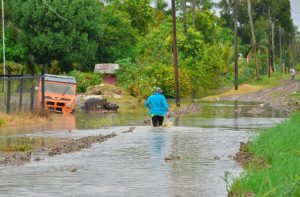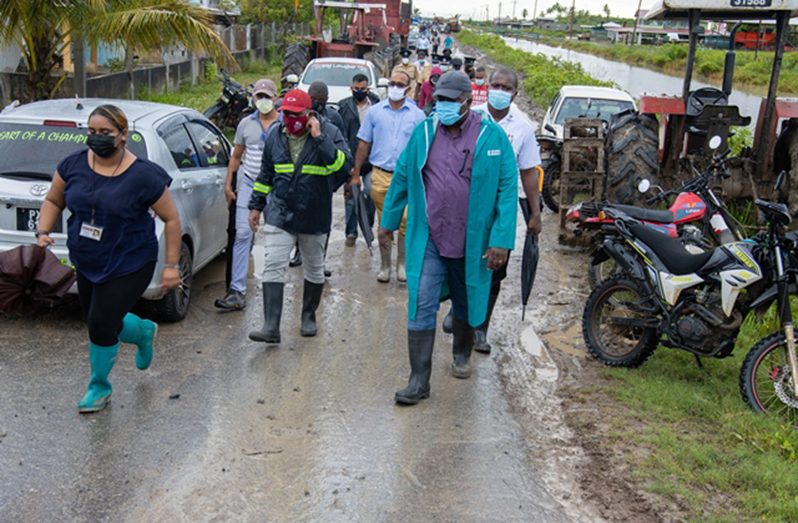–as regional officials report damage to infrastructure, farmlands
AS regions continue to grapple with the effects of persistent flooding caused by heavy rainfall and spring tides, the Government of Guyana has started mobilising support not only to mitigate the impact of the situation, but to also ensure that residents are able to sustain themselves.
Flooding is reported in areas in Regions Two (Pomeroon-Supenaam), Three Essequibo Islands-West Demerara), Four (Demerara-Mahaica), Five (Mahaica-Berbice), Six (East Berbice-Corentyne), Seven (Cuyuni-Mazaruni), Nine (Upper Takutu-Upper Essequibo) and Ten (Upper Demerara-Berbice). All sluices were opened at low tide, and the water is receding in some areas. The National Drainage and Irrigation Authority (NDIA), according to the Department of Public Information (DPI), will continue the necessary interventions to bring relief to affected residents and farmers. In Region One, water level remains high in the creeks, while some internal roads have been eroded and are impassable in some areas, from Six Miles. There, farmers lost cash crops and poultry. Over in Region Two, to alleviate the situation and ensure that it does not worsen, the NDIA plans to continue the maintenance of the outfall channels and pumps. Also, sluices will be opened, based on the tides. The authorities recently received an approval tender for the replacement of the Capoey sluice, and has opened tenders as part of its capital works to empolder farmlands. In Region Three, there are reports of flooding at Ooku in both residential as well as farming areas, farmlands at North and South Section, Debuff, and there is a conservancy seepage at Canal Numbers One and Two.

In response, instructions have been given to the Water Users’ Association (WUA) to conduct “mechanical pulling” of both main drains in Canal Numbers One and Two.
The Ministry of Public Works has also deployed two machines, along with one from the Guyana Sugar Corporation (GuySuCo), to clear clogged drains in areas such as Tuschen/Zeelugt Scheme and Railway View/Meten-Meer-Zorg. The water has receded in Wakenaam, Sans Souci, Maria’s Pleasure and Maria Johanna.
In Region Four, two sluice doors have been replaced at Alliance, and repairs are ongoing at another. The Indian pump supplier is currently working to repair or replace the broken drive shaft of the new pump at Nooten Zuil. In the interim, a mobile one has been installed and is in operation. Additionally, a contractor is currently executing works at the Belfield 40 cusec pump.
The NDIA has deployed two excavators on the right bank, and another two on the left bank of the Mahaicony Creek to reinforce the flooded embankment. The authorities have also cleared the channel of the Mahaicony Creek, and mobilised a mobile pump at Gordon Table in Region Five.

Interventions in Region Six include the deployment of four excavators to Black Bush Polder, repairs to the pump at Eversham; the installation of two tractor pumps to drain flood waters at Canje Cane Field and Adelphi; desilting of the outfall at Borlam; installation of a pump at Adventure and Number 47; and the commencement of dredging at Number 43, Eversham, Lesbeholden, and Numbers 51 and 52. In Region Nine, the water has receded minimally in some areas such as Tabatinga and the Culvert City housing area.

In Region Ten, mechanical cleaning is being executed in Coomacka. A contractor is working on an erosion project, and tubes are being installed at the Coomacka mines. The NDIA will undertake cleaning with the help of Community Development Councils shortly.
Ministers of Government have been visiting communities affected by flooding, throughout the country, and will continue to do so in the coming days. Relief hampers and other support have been provided. Minister of Agriculture, Zulfikar Mustapha is expected to revisit Black Bush Polder and other areas in Regions Six.

SEVERELY FLOODED
In speaking about the situation in Region Six, Chairman of the Regional Democratic Council (RDC), David Armogan related that heavy rainfalls throughout Wednesday night and early Thursday morning resulted in several communities being severely flooded.
“The flooding is continuing because we had heavy showers of rain again last night and this [Thursday] morning, so the water levels in Black Bush Polder have risen and in 74 and 52 area we got flooding in some of those areas. Virtually, we got flooding right across the region,” Armogan said.
He added that besides interrupting residents’ daily lives, the heavy rainfall and increased flooding has also affected the region’s agriculture sector, with many reporting losses of crops and poultry. “Some of the residential areas are not affected, the places that are most affected are the farm areas, some areas in 74, Crabwood Creek and Black Bush Polder,” Armogan said.
He said too that many farmers are currently unable to gain access to their farmlands since all access dams and agriculture roads are in a ‘disastrous’ state due to the heavy rainfalls.
“All the roads in Black Bush Polder are completely gone …so as soon as we get some dry weather we got to back and spend millions of dollars and get those dams ready again,” Armogan lamented. Meanwhile, Bartica’s Mayor Gifford Marshall said that while the water had started to recede on Wednesday evening, due to spring tides early Thursday morning, several areas within the township were still grappling with what can be described as the ‘worst’ flood to ever hit the region.
“Fellow Barticians, a few hours ago we witnessed what was definitely the worst flood in our recent history. Given, the support of all stakeholders, the water receded in record time. However, I regret to inform you that this new day has brought us new challenges. The spring tides are with us,” Marshall said.
In Region Nine, several residents are still grappling with heavy rainfalls and floods after two weeks. The situation in this region exacerbated by water from the Amazon Rainforest in Brazil travelling through the Rio Negro River to the Brancho River and, eventually, into the Region.
The Regional Chairman of the Region Nine RDC, Brian Allicock, in a separate interview, told the Guyana Chronicle that there have been several reports about infrastructure being severely damaged; this includes roads, cassava farms, and farine and bread-making shops.
“Almost all the villages their crops, farms are under water, cassava and we are giving residents food aid now…waters are over the road making it hard to traffic, some teachers can’t go because they normally go with motorcycles but the water is too high, so some places we using lorries to travel,” Allicock said.
He added that with persistent rainfall, instances of flooding continue to be recorded in a number of communities.


.jpg)











